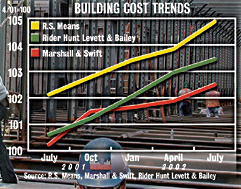On the other hand, inflation measured by contractor selling price indexes, which reflect the competitive conditions of the marketplace, show an annual increase of just 0.8% this quarter. This is down from a 2.5% annual inflation rate measured by this group of indexes in the same quarter of 2001.
The relatively wide 1.7% spread between indexes that measure input costs and selling price is a strong indication of how deeply contractors are trimming margins to stay competitive. A year ago, when the market was rosy, there was no gap between the two types of indexes.
 |
| Source: R.S. Means, Marshall & Swift, Rider Hunt Levett and Bailey |
NEW MEASURE
This quarter, ENR introduces a new general building cost index to its lineup. The 10-city composite index compiled by construction consultant Rider Hunt Levett & Bailey, Phoenix, shows a 2.8% annual inflation rate. The index prices a basket of 42 items found in an average building, including materials and labor. However, unlike most other general building cost indexes, RHLB also factors in general conditions, contractor overhead and profit and sales taxes.
The RHLB index reflects cost trends in the 10 cities where the firm has offices. "Southern California has the highest inflation rate," says Julian Anderson, president of RHLB's North American Group, which has an office in Los Angeles. "Our Seattle and Ft. Lauderdale offices report the lowest inflation rates."
Anderson says construction inflation in Phoenix is about 2.5%, but he believes that could drop to zero by next year. A lot of commercial work there is just winding down and Anderson expects the market to be much tougher next year when the local building market is hit with high vacancy rates. The expected slowdown in commercial work will be compounded by state budget problems, which could cut into public works projects. "We may even see some deflation next year," Anderson says.
In Boston, RHLB Associate Principal Grant Owen says annual inflation is down to 3%, or less than half of what it has been in recent years. "With the 'Big Dig' coming to a close, we expect to see some price reductions in concrete and aggregates, but at the moment there have been no dramatic changes," he says.
A sharp downturn in the tourist industry is hurting the Florida market and keeping a cap on costs, says Tony Smith, who runs RHLB's Ft. Lauderdale office. "Inflation in this area is down to 1 to 2%," he says. "Before the tourism slump, inflation was 3 to 4%."
he persistent gap between general building cost indexes and selling price indexes continues to indicate a very competitive market with steep discounting. During the third quarter, the general building indexes, which measure the input cost of labor and materials, jumped 1.1% as new wage settlements started to roll in. This was 0.1% less than 2001's third quarter increase. As a result, annual inflation held at 2.5%, about the same annual inflation rate measured by this group of indexes a year ago.
Post a comment to this article
Report Abusive Comment